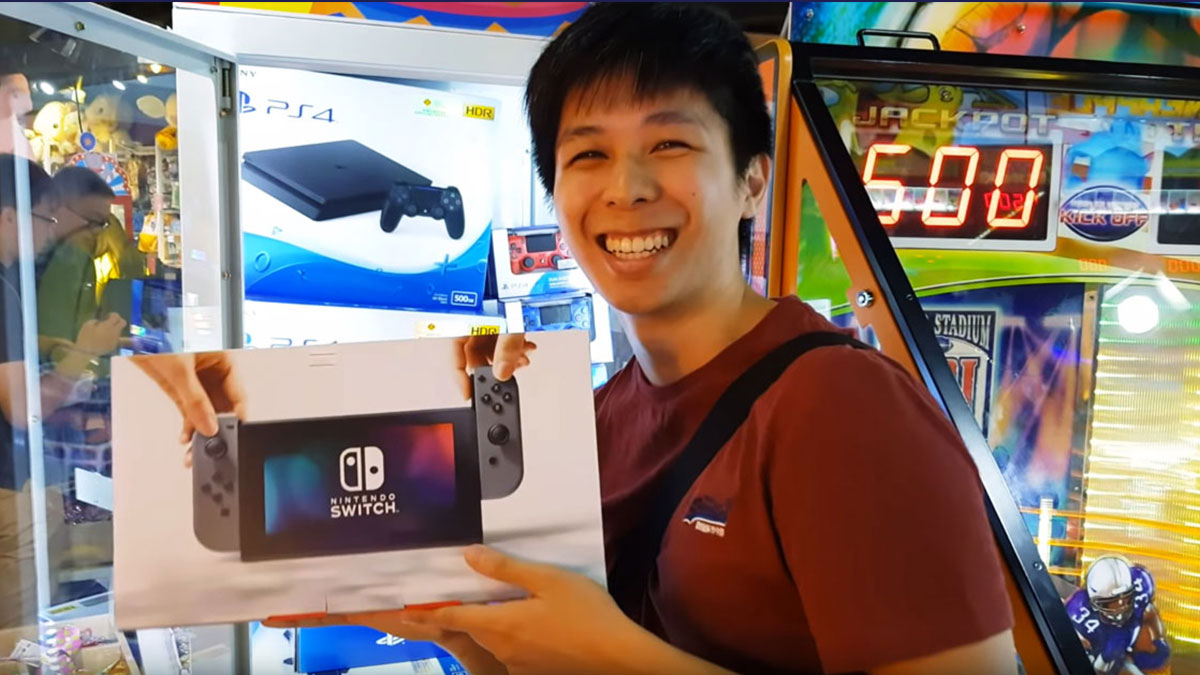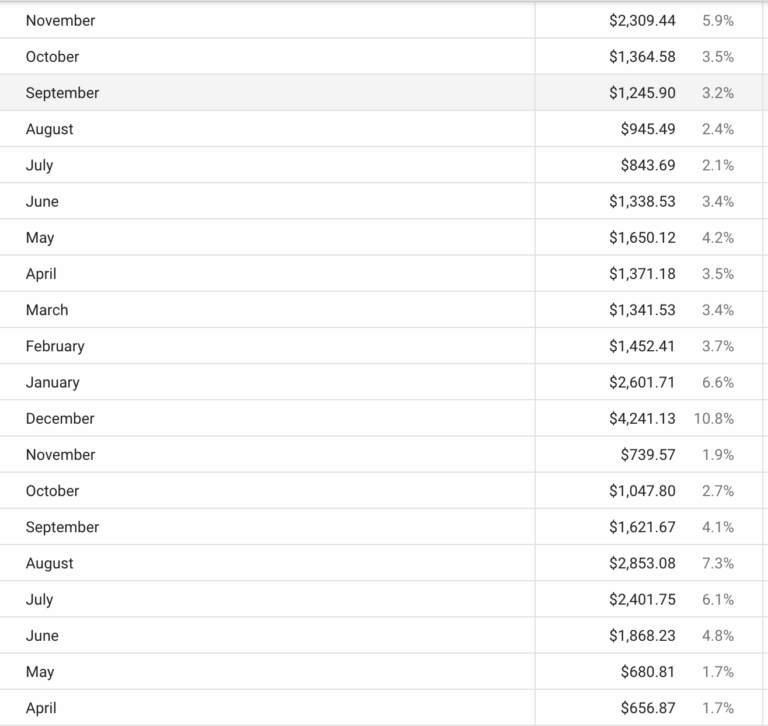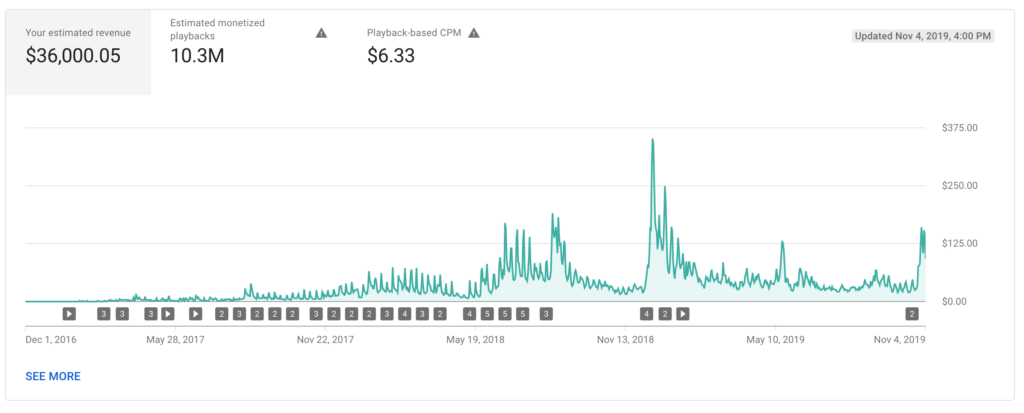Life | Personal Stories | Article
Earning $1,000 a Month Playing Claw Machines
by Sophia | 24 Dec 2019 | 10 mins read

We use YouTube for almost everything, from watching music videos to learning new skills from tutorials. YouTube has become so ingrained in the media landscape that we don’t even blink (as hard) anymore when we hear of someone considering a career around Youtube.
But when we think ‘monetisation’ we instinctively think about content creators making a killing on the platform, earning up to USD$8M a month. However, what about ‘grassroots’ content creators on YouTube? The ones with a respectable 50,000 or so views per video — but not quite YouTube superstars. How much can these content creators earn off the platform?
Is making money on YouTube simply the case of going big or going home?
So when Alan, a software engineer, and his wife Fynn, a project manager, contacted us about a YouTube channel they created, with real proof they’ve had financial success on YouTube — netting $36,000 over three years from the platform (or an average of $1,000 a month) we leapt at the chance to find out more.
And their content? Making videos about claw machine and arcades. We talked to Alan to find out how he melded such a niche hobby with monetisation.
So, how did you and your wife get started?
We got really addicted to UFO catchers and claw machines after a trip to Tokyo in 2015.
After we came back to Singapore, we started to frequent Suntec City’s arcade on a weekly basis where we’d spend $100 to $200 for the thrill and challenge of catching a toy from the claw machines.
I realised soon that our hobby was costing us a significant amount of money every month. Around this time, we discovered Umehara Keiji, a local YouTuber, who produced claw machine videos. We then realised that all our clawing sessions were actually content that can be used on YouTube and potentially provide us with some income.
Initially, all we wanted to do was to make some ad revenue from YouTube so that we can continue to enjoy claw machines without it impacting us financially. Fast forward three years, our channel is now a source of passive income for us since the old videos continue to generate revenue even if we do not post new content.
How did you increase your viewership in the beginning?
When we had zero subscribers, YouTube’s recommendation engine would not recommend our video because our channel did not have enough views — as views and subscribers are data points that YouTube’s engine uses to determine if a video should be recommended.
So we posted links to our videos on claw machine Facebook groups, online forums and Reddit to try and get some traction. We gained most of our initial audience from a Taiwanese claw machine Facebook group which had over 20,000 members.
Thinking back on those days, it was really a grind because we had to manually share the link for every new video we made.
What’s an average, concrete figure of how much you earn every month?
This is a screenshot of our actual revenue over the months, from April 2018 to November 2019 (bottom to top):

Why claw catching machines and arcade games in general? Is there a big audience for this?
We enjoy the thrill and challenge of winning a toy from the machine. Since claw machines are essentially a game of chance, people become addicted when the odds are in their favour.
Honestly, it’s an addiction. But one thing I felt we did right was we were frank with ourselves and made sure it wouldn’t financially impact us negatively.
Regarding the audience, the only indicator initially was that we’d notice a crowd always forming around us whenever we were trying our luck at the claw machines. From that observation, we felt that videos might also appeal to an online audience.
That assumption was validated! We found YouTubers in the US that had hundreds of thousands of subscribers just by making claw machine and arcade content.
Why do you think there’s such a huge appeal for this type of content?
I think it is actually a form of entertainment just like how people would watch game streamers play games.
Speaking of streamers, do you think live streaming claw machine sessions is a viable option apart from just recording and uploading videos?
There is actually a service called Toreba where you can play UFO catchers online and win limited edition prizes from Japan. We used to livestream Toreba on YouTube but it didn’t make economical sense since there isn’t a good way to monetise livestreams when we tried it. We may reconsider it again in the future.
Another point on why we don’t live stream is because we can’t edit the video for live stream; a good video needs to be well-edited such that we’re able to retain the audience’s attention for as long as possible.
At what point did your ad revenue begin to be sufficient to cover the cost you’re spending on claw machines?
It took us almost a year and a half before we saw significant revenue where we got to a stage where we get to “play for free”. In the initial year, it was really us learning about how to make videos that were able to retain the audience’s attention.
Do you only use the ad revenue money to pay off the cost of using claw machines, or do you funnel earnings elsewhere?
The ad revenue is used to offset the cost of producing videos for our channel. For any remaining amount, we put it in a joint account that forms part of our savings for retirement. In some way, it’s extra income for our family.
Are you guys planning to aim higher for more ad revenue and views in the coming year?
Yup. Our goal now is to get 100,000 subscribers so that we can get the YouTube silver play button, while at the same time generating sufficient views to maintain a decent side income.
What do you get with a silver play button?
Apart from the physical silver play button, at 100,000 subscribers, we’ll also get a partner manager from YouTube to work with.
Writer’s note: A partner manager is essentially a personal YouTube expert, who will work with the YouTuber to optimise their content and channel by crafting goals and strategies. Other perks include providing exclusive invitations to the YouTuber to creator events and workshops.
How exactly does monetisation work on YouTube? Is it more than views?
It’s based on a revenue-sharing model for every advert shown in the video. YouTube takes 45% while the creator takes 55%. If there’s more than one advertisement in a video, both YouTube and the creator earn more.
So should a YouTuber put more ads? Won’t it put audiences off? What’s the balance between the two?
This will depend on the cost of creating your content. For the both of us, the cost of creating our content is high (due to how much we spend at arcades), so the only way for this YouTube channel to be sustainable is to put in about four advertisements per video. There are definitely downsides to putting in more advertisements, but my hypothesis is that viewers are desensitised to them nowadays — every video comes with ads.
Do you think this content is sustainable for the next, say, 5 years?
I hope so, but I’m not sure. A trend we’ve seen from the more successful claw machine YouTubers is to expand to a different vertical once they have a significant subscriber base. That is what we’re considering doing at the moment.
What kinds of different verticals?
We’ve seen the other YouTubers expand into personal lifestyle vlogs or even expand into the gaming vertical. But at this current point in time, we’re not thinking of expansion but rather focusing on our core of claw machines and arcade videos.
Do you engage with your viewers or followers? What’s the best part about having so many subscribers on YouTube, apart from the ad revenue?
We actually engage with our viewers, but to be honest, the revenue is the motivating factor for us at the moment — it has the potential for one of us to do it full-time at some point.
How much do you think your personalities and likability factor into your popularity?
Our content is a bit special, in the sense that Fynn and I aren’t actually the main focus of the videos we produce, but the games we play instead. Therefore, I think our personalities don’t factor in all that much when it comes to popularity.
Do you think anyone can monetise anything on YouTube, if they do it well enough?
Yes, I do think so. One thing we learnt over the course of three years is that the pie is not finite on youtube. There are so many viewers globally, even new/small creators are able to carve out a niche for themselves.

Does this side gig take up a lot of your time? How many hours in a week, for example?
I would say it takes about three to four hours a video followed by an hour of editing. Since we’re making a video a week at the moment, we spend about five hours a week on the channel. Now that I think about it, it pretty much takes up one full day on the weekend but the good thing is that we’re still enjoying it.
If this could one day generate enough revenue for you guys to do it full-time, would you take the chance?
Since we had our child, my wife has decided to leave her role in order to spend more time with our kid. In order to supplement the loss of full-time income, she plans to devote more time to create content for the YouTube channel.
What’s the most popular video you have so far and why do you think it worked?
Our most popular video is the one with the coin pusher that used small white pearls instead of the traditional coins. It’s really hard to tell why YouTube decided to promote the video so much, though. I did try to make sense of the analytics, but did not get anything conclusive. However, we’ve come to realise that the thumbnail of a video can make or break the content because it’s used to primarily compete with a lot of other videos that YouTube suggests on a user’s homepage or dashboard.
What advice would you give to budding YouTubers?
Figure out a routine and stick to it for a couple of years. I mean, even after three years, we’re not wildly successful. But without a proper routine, we would not have grown our channel to where it is today. It also gets a lot easier as your channel grows, since YouTube will start to favour and recommend your videos to more viewers.
For the last three years, Alan and Fynn have been hard at work creating content for Catch a Toy, their YouTube channel — with some success. So if you have a hobby as niche as theirs — that might have an audience — and perhaps you too could be earning some side-money from YouTube.
















